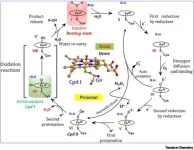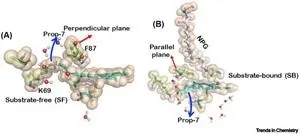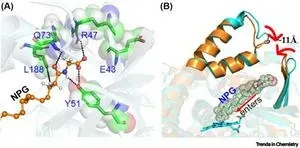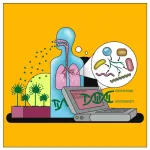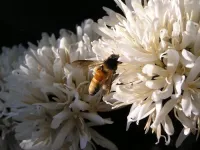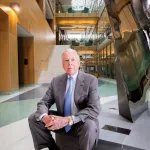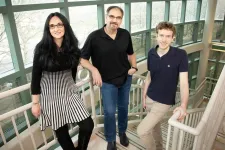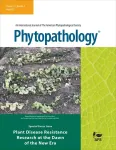(Press-News.org) [Jerusalem, Israel] Study reveals an important discovery in the realm of nanomachines within living systems. Prof. Sason Shaik from the Hebrew University of Jerusalem and Dr. Kshatresh Dutta Dubey from Shiv Nadar University, conducted molecular-dynamics simulations of Cytochromes P450 (CYP450s) enzymes, revealing that these enzymes exhibit unique soft-robotic properties.
Cytochromes P450 (CYP450s) are enzymes found in living organisms and play a crucial role in various biological processes, particularly in the metabolism of drugs and xenobiotics. The researchers' simulations demonstrated that CYP450s possess a fourth dimension - the ability to sense and respond to stimuli, making them soft-robot nanomachines in "living matters”.
In the catalytic cycle of these enzymes, a molecule called a substrate binds to the enzyme. This leads to a process called oxidation. The enzyme's structure has a confined space that allows it to act like as a sensor and a soft robot. It interacts with the substrate using weak interactions, like soft impacts. These interactions transfer energy, causing parts of the enzyme and the molecules inside it to move. This movement generates ultimately a special substance called oxoiron species, which serves the enzyme to oxidize a variety of different substances.
The key takeaway from these molecular-dynamics simulations is that the catalytic cycle of CYP450s is complex but follows a logical sequence. The enzyme's restricted space, strategic residue placements, and channels allow it to be a sensitive sensor of the substrate, its own heme changes, and conformational shifts in the active site. This sensing-response capability creates a soft-robot with a fourth dimension of sensing, something previously unseen in regular 3D matter.
"We have discovered that CYP450s act as soft-robot machines in 'living matters,' displaying a remarkable sensing and response-action capability. This is an exciting revelation, and we believe that similar mechano-transduction mechanisms of soft-impact cues might be at work in other soft-robot machines in nature," stated Prof. Sason Shaik, one of the lead researchers.
The findings open up new avenues in soft-robotics research, as 4D materials are gaining significance, driven by external triggers. These materials, such as hydrogels produced through 3D printing, resemble enzymes in their ability to sense and induce changes. The implications of this discovery extend beyond the realm of biology and chemistry, potentially revolutionizing fields like artificial intelligence design and self-evolving polymers/gels synthesis.
Dr. Kshatresh Dutta Dubey, co-researcher of the study, added, "We are entering an exciting era for chemistry, where soft-robotics and intelligent design of nanomachines can lead to unprecedented advancements. The future may witness the creation of self-evolving polymers and perpetual nanomachines capable of synthesizing new molecules at will."
The scientists believe that the integration of the soft-robotic language and machine programming could accelerate progress in the development of 4D materials and unlock the full potential of soft-robotics.
For more information about the study, please refer to the article: “Nanomachines in Living Matters: The Soft-Robot Cytochrome P450” Trends in Chemistry, In press (2023).
END
Discovery in nanomachines within living organisms - cytochromes P450 (CYP450s) unleashed as living soft robots
2023-08-07
ELSE PRESS RELEASES FROM THIS DATE:
Scientists crack the code of what causes diamonds to erupt
2023-08-07
An international team of scientists led by the University of Southampton has discovered that the breakup of tectonic plates is the main driving force behind the generation and eruption of diamond-rich magmas from deep inside the Earth.
Their findings could shape the future of the diamond exploration industry, informing where diamonds are most likely to be found.
Diamonds, which form under great pressures at depth, are hundreds of millions, or even billions, of years old. They are typically found in a type of volcanic rock known as kimberlite. Kimberlites are found in the oldest, thickest, ...
A fungus gets comfortable
2023-08-07
Aspergillus fumigatus strains that infect humans have a significantly altered metabolism compared to other strains in the environment. At the same time, infection with the fungus leads to an apparent change in the human lung microbiome. Researchers at the Leibniz Institute for Natural Product Research and Infection Biology (Leibniz-HKI) in Jena, Germany, came to this conclusion after using machine learning models to analyze genome data from about 250 fungal strains and lung microbiome data from 40 patients.
The fungus Aspergillus fumigatus is widely distributed in the environment, where it performs important ecological functions. ...
CEHD researchers receive funding for project on quantum teaching & learning in elementary classrooms
2023-08-07
Nancy Holincheck, Assistant Professor, Advanced Studies in Teaching and Learning, School of Education; Jessica Rosenberg, Associate Professor, Physics and Astronomy; Stephanie Dodman, Associate Professor, School of Education; and Benjamin Dreyfus, Associate Professor, Physics and Astronomy, received funding from the National Science Foundation for the project: "EAGER: Quantum is Elementary: Quantum Teaching & Learning in Elementary Classrooms."
The researchers will study learning associated with elementary teachers' engagement in professional learning and elementary students' learning related to quantum science, quantum thinking, and careers. The ...
More work needed to unlock mysteries of Asia’s bees
2023-08-07
Although the collapse of hives of European honey bees (Apis mellifera) has gained worldwide attention in recent years, there are massive gaps in knowledge of other bee species, particularly in the Asian region, which contains over half the world’s human population and where food security (in which bees play a key role) remains a major challenge.
According to a recent global analysis, only 1% of the global public data on bee distribution comes from Asia, even though 15% of the world’s bee species are thought to live there.
In a new paper, “Opportunities and challenges in Asian bee research and conservation”, published in the journal ...
Symptoms of the body and the mind are frequent fellow travelers
2023-08-07
INDIANAPOLIS – Chronic pain is often accompanied by depression and anxiety. In an invited commentary published in JAMA Network Open, Kurt Kroenke, M.D., of Regenstrief Institute and Indiana University School of Medicine, discusses the relationship between pain, the most common symptom for which individuals visit a physician, and depression and anxiety, the two most prevalent mental health conditions worldwide. He highlights the importance of not neglecting psychological symptoms in patients experiencing pain.
“One of the reasons for the bi-directional linkage between pain and depression, as well as anxiety, is the existence of a feedback ...
T. Boone Pickens Foundation donates $20 million to Wilmer Eye Institute, Johns Hopkins Medicine
2023-08-07
The T. Boone Pickens Foundation, established by the late, Texan innovative energy leader and philanthropist, is donating $20 million to the Wilmer Eye Institute, Johns Hopkins Medicine. The gift, announced in 2013, is one of the largest research donations in Wilmer’s history. It will fund vision-saving research and a professorship.
Pickens’ interest in the treatment and research of eye conditions developed in the 1980s after his father’s diagnosis of macular degeneration, a progressive condition that disrupts the central field of vision and causes ...
SwRI helps create open-source software to assist rail industry decarbonization efforts
2023-08-07
SAN ANTONIO — August 7, 2023 —Southwest Research Institute is helping the freight rail industry assess potential pathways to decarbonization with a new open-source modeling and simulation software known as ALTRIOS. ALTRIOS, the Advanced Locomotive Technology and Rail Infrastructure Optimization System, can simulate the real-world impacts and expenses related to adopting alternative energy locomotive technologies and expanding associated infrastructure.
Now publicly available for download, ALTRIOS supports several simulation modes to provide rail industry stakeholders with optimal strategies for implementing ...
A promising investigational therapeutic monoclonal antibody to treat chronic hepatitis B and D infections
2023-08-07
Affecting hundreds of millions of people, chronic hepatitis B is a widespread global health problem for which there is as yet no cure. In a preclinical study involving the German Center for Infection Research (DZIF), Heidelberg University Hospital, University Medical Center Hamburg-Eppendorf and the US company Vir Biotechnology, the potential of an engineered investigational human monoclonal antibody for the treatment of chronic hepatitis B and hepatitis D has been demonstrated. Based on the results, clinical trials with the monoclonal antibody VIR-3434 are ongoing.
Chronic hepatitis B ...
Study: People expect others to mirror their own selfishness, generosity
2023-08-07
CHAMPAIGN, Ill. — New research shows that a person’s own behavior is the primary driver of how they treat others during brief, zero-sum-game competitions. Generous people tend to reward generous behavior and selfish individuals often punish generosity and reward selfishness – even when it costs them personally. The study found that an individual’s own generous or selfish deeds carry more weight than the attitudes and behaviors of others.
The findings are reported in the journal Cognitive Science.
Previous research into this arena of human behavior suggested that social norms are the primary factor guiding a person’s decision-making in competitive scenarios, ...
Gene grants powerful resistance to resurging plant disease
2023-08-07
While wrapping oneself in 100% Egyptian cotton bedsheets is a delightful luxury on a warm summer night, cotton provides much more than breathable, soft fabric. In addition to textiles, the cotton plant is grown for food, fuel, and daily-use consumer products—such as coffee filters, currency, and moisturizers. However, a resurging plant disease called bacterial blight is currently threatening cotton production worldwide.
Bacterial blight is best controlled through natural, genetic resistance. ...
